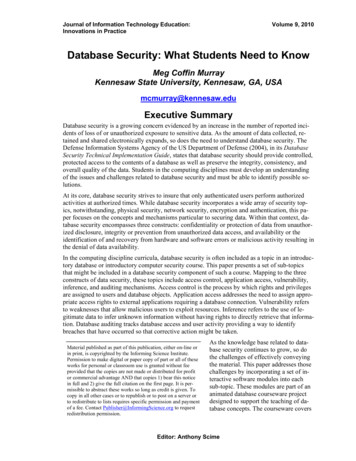
Transcription
A First Data White PaperWhat Merchants Needto Know AboutCross-Border eCommerceThe Web is a level playing field that lets businesses of allsizes participate in the global marketplace. But what is thebest way for online businesses to expand internationally?Should a business create one large Web presence andthen drive traffic to it? Or is it better to create a seriesof local market/cross-border sites optimized for regionalbuyers? This paper recommends the latter approach,providing an overview of cross-border eCommerce andexplaining to merchants what they need to know toharvest more international business.By Souheil BadranSenior Vice President & General Manager, eCommerce SolutionsFirst Data 2008 First Data Corporation. All trademarks, service marks and trade names referenced in this material are the property of theirrespective owners.
What Merchants Need to Know About Cross-Border eCommerceA First Data White PaperGoing Global with eCommerce:One Size No Longer Fits AllAs eCommerce extends the reach of regional business to the global marketplace, merchants are presentedwith huge revenue and growth opportunities. Until recently, organizations often engaged in eCommerce bybuilding a single Web site and then driving traffic to it from around the world.While some companies still rely on this model, the one-size-fits-all approach is increasingly being displacedby cross-border eCommerce. In this scenario, optimized, country-specific sites and eCommerce solutions aredeployed for each major market. For example, iconic American motorcycle company Harley-Davidson now has25 cross-border sites around the globe.Country-specific sites work better to attract and service customers in those countries than the multinationalapproach, but they present a host of challenges for merchants unfamiliar with the territory. The challenges includemaintaining information in multiple languages, greater product differentiation, customer service issues and amore complex supply chain. Additionally, the business must deal with a host of payment-related issues, includingincreased fraud risk, currency conversion, merchant banking relationships and regulatory requirements.This paper is for any business that is either already engaged in global commerce or is considering expandingbeyond current domestic markets. It outlines the key challenges in cross-border eCommerce with a specificfocus on payments, which until now have been particularly difficult to manage for global online merchants. Thepaper explains how payment processors like First Data deliver turnkey cross-border solutions that reduce cost,complexity and potential fraud risks. This model enables merchants to focus on what they do best: enhancecustomer value by designing and delivering great products and services, while outsourcing cross-borderpayment management.What Exactly Is “Cross-Border” eCommerce?Global eCommerce and cross-border eCommerce are easily confused, and many might use the termsinterchangeably. But there is more than semantics at play here.Think of global eCommerce as the sum of all eCommerce transactions worldwide. These include transactionsmade between buyers and sellers in the same country and buyers and sellers in different countries. Indeed,the entire global eCommerce boat is rising. For example, according to industry analysts:J Global eCommerce will reach 711 billion in sales by 2010 eMarketer)J This number is growing at a compound annual growth rate (CAGR) of 19 percent eMarketer)J The United States will go from 175 billion in online sales in 2007 to 335 billion by 2012(Forrester Research)J 32 million United Kingdom consumers will be shopping online by 2011 Forrester Research)J 134 billion will be spent online in China by 2012 IDC) 2008 First Data Corporation. All rights reserved.firstdata.compage 2
What Merchants Need to Know About Cross-Border eCommerceA First Data White PaperThe consulting and research firm Glenbrook Partners is even more bullish on the global eCommerce market,predicting it will grow to 967 billion by 2010. As Figure 1 shows, Glenbrook also sees an emerging trend inwhich markets outside of North America represent an increasingly greater share of eCommerce revenue.Figure 1. Shifting eCommerce Purchase VolumeThis trend is where the distinction between global and cross-border eCommerce becomes more important.If a French buyer comes to www.amazon.com and makes a purchase, it is certainly global eCommerce. But ifthe buyer visits www.amazon.fr and makes a purchase on Amazon’s French-specific site, that’s considered across-border transaction for Amazon.Amazon and other eMerchants know that to win more business in France—as well as in Germany, Japan, Chinaand other fast-growing eCommerce markets—they have to have an in-country presence. Why?J More convenient for customersJ More attractive localized product offeringsJ Better, more persuasive communication due to local language translationJ Less expensive shipping options for customersJ Higher rankings on search engines and greater ability to attract customersJ Ease of payment options for the customer 2008 First Data Corporation. All rights reserved.firstdata.compage 3
What Merchants Need to Know About Cross-Border eCommerceA First Data White PaperIn short, if eMerchants want to get more international business, they must deploy cross-border eCommercesolutions. Indeed, a 2007 survey by Glenbrook showed that 63 percent of all eMerchants that responded wereselling internationally, and of those that were not—48 percent would be doing so within a year. Glenbrookfurther estimates that 15 to 20 percent of large U.S. eMerchant sales volume comes from cross-border Websites. Figure 2 shows the breakdown by region.Figure 2. eCommerce by RegionIs Cross-Border Just for the Big Boys?Not at all. While everyone would expect Amazon, eBay, Nokia and Nike to be taking the lead in cross-bordereCommerce, a surprising number of small and medium-sized businesses have built true international businesses.Take, for example, Crocs Inc. The U.S.-based footwear and apparel maker saw its sales soar to 840 million in2007 (up from 354 million in 2006). The company has used an extensive network of cross-border Web sitesto fuel its growth. At last count, it had more than 45 such sites, including sites in Hungary, Monaco, Thailandand Malaysia.But even Crocs would be considered large compared to SpaFinder Inc. The online media and travel companyspecializes in “vertical search” by connecting consumers with spas and resorts worldwide. Dun and Bradstreetreports that the privately held company’s 2007 revenue was 6.1 million. However, business is growing and isbeing fueled by an array of cross-border, country-specific sites. The company has seven Web sites in the U.S.,United Kingdom, Spain, France, Japan, Germany and Italy. 2008 First Data Corporation. All rights reserved.firstdata.compage 4
What Merchants Need to Know About Cross-Border eCommerceA First Data White PaperCrocs and SpaFinder are not alone. According to a recent survey by global delivery and logistics provider UPS,33 percent of small U.S. eRetailers engage in cross-border eCommerce. That number is sure to increase duemostly to the huge overseas opportunity as shown in Figure 3.Figure 3. Markets for eCommerceChallenges and Risks in Cross-BordereCommerce ExpansionAs anyone who has participated in setting up international businesses or cross-border Web sites will tell you,these are non-trivial endeavors. Most successful eMerchants will say it is well worth the effort, but newcomerswill face a few challenges.Language: Modern content management systems make handling multiple Web sites in different languageseasier than before. Nonetheless, all content needs to be initially translated, then localized and then testedto make sure it is appropriate for the country or locale. This goes for site content, shopping carts, salescomparators and other related tools.Local product differentiation/inventory issues: Obviously, Amazon does not want to feature Japanese bookson its French Web site. The same applies to other companies that must maintain multiple SKUs, productdescriptions and images, safety and regulatory guidelines, and other information on multiple sites. 2008 First Data Corporation. All rights reserved.firstdata.compage 5
What Merchants Need to Know About Cross-Border eCommerceA First Data White PaperDistribution/shipping costs/timing: To launch eCommerce in a new country, retailers face a host of local andglobal supply chain issues, including transportation, logistics and warehousing. This is why many companies,especially smaller ones, rely on outsourced regional experts known as third-party logistics (3PL) companies.These companies handle distribution, warehousing, inventory management and even enterprise resourceplanning (ERP) system management for a fee.Local competition/pricing: Obviously, each local market is competitive in its own right. For large eMerchants,like Nokia, these differences can be startling. For example, in Europe, mobile phones are largely soldindependent of carrier plans or promotions. In the U.S., this is completely different and most phones arepurchased “bundled” with carrier plans. Marketers, webmasters and others involved in cross-border sitesmust be constantly attentive to the latest changes in localized consumer habits, Web traffic, promotions, andother related marketing and sales issues.Customer service: Historically, the online channel was developed as a self-serve model for consumerswho had little expectation of customer service or support. That has changed—customers now expectbrick-and-mortar levels of service from eMerchants. So, how is customer service handled? Is it facilitated bya 24x7x365 centralized facility, or by a string of regional centers? What about returns, or the “reverse supplychain” as it is called? These are just two of the many important in-country customer service issues that mustbe handled.Payments Present Special ChallengesMost business professionals have had some past experience or familiarity with products, inventory,merchandising, promotions and logistics. But few have any hands-on experience with electronic payments.Payments have typically been the purview of bankers and accountants. And even for financial professionals,payment systems have represented the murky “plumbing” that few really understand.Yet managing and implementing a viable payments system is critical to cross-border eCommerce success.Here are some of the issues to be concerned with:Payment TypesIn the United States, the credit card is the most widely used method for online purchases. But studies showthat alternative methods—such as PayPal, Bill Me Later and Google Checkout, to name just a few—havecaptured a significant market share. In fact, according to a 2008 Forrester Research survey, 74 percent ofonline shoppers report using an alternative payment method at least once. In Europe, although credit cardsare commonplace, many purchases are made with inter-bank transfers—something that is not done in theUnited States except in business-to-business (B2B) markets. In the United Kingdom, debit cards are usedextensively for online purchases; in China, many online purchases are made with cash.So, deciding which payment methods to accept and how to do it can really be a critical and complex task. Yet,if you really want to optimize online sales globally, you have to be prepared to consider all the alternatives. Thewider you can cast your payments net, the more sales you will harvest.Currency ConversionThe cost of currency conversion is usually borne by the buyer—rarely by the seller or merchant. So, if Germanbuyers want to buy an American item that is offered for sale only in U.S. dollars, then they pay a fee to havethe currency converted to euros on their next card statement. Of course, depending upon exchange rates atthe time, they may wish to pay directly in euros, if that is an option. 2008 First Data Corporation. All rights reserved.firstdata.compage 6
What Merchants Need to Know About Cross-Border eCommerceA First Data White PaperUntil recently, merchants could offer consumers few choices for currency conversion or purchasing options.This inhibited global eCommerce by effectively passing on currency surcharges to consumers. That problem israpidly diminishing, because currency conversion options are now easily available from eCommerce providerslike First Data and others. This enables cardholders to make an informed decision during the checkout processto either pay in their own currency at a competitive and fully disclosed exchange rate inclusive of any fees, orto allow the card association to convert the transaction at an unknown exchange rate and assess a conversionfee. The proliferation of choice and customer control is expected to rapidly accelerate global eCommerce.Taxes (VAT)Value-added tax (VAT) is a tax paid by buyers located in the European Union, Canada, Australia and manyother countries. If you sell online to someone located in Europe, you have to calculate the VAT and pay it to thecountry in which the item was sold. Complicating the issue, each country can set its own VAT rates. The goodnews for the merchant is that the buyer pays the VAT. The bad news is that merchants have to collect it andsubmit it to the proper authority. One of the advantages of using third-party payment networks is that theycan handle these complex VAT issues for you.Global Network of Acquiring BanksTo conduct business online and accept credit cards and some other forms of payments, merchants mustestablish merchant banking relationships. The merchant’s bank is known as the acquiring bank, and theconsumer’s bank that issued the credit card is known as the issuer bank.To provide global eCommerce services, many companies have traditionally set up relationships with multipleacquiring banks in the various regions they do business in. Sometimes this is because it was the only viablesolution. In other cases, foreign countries may insist upon an in-country banking relationship as a prerequisitefor doing business in that country. Merchants often pay a price for these multiple banking relationships inthe form of higher fees as well as the increased complexity of reporting and managing multiple relationships.Next-generation eCommerce infrastructure is now providing for a single acquiring relationship, which ishelping to reduce the cost and complexity of global eCommerce.Fraud and Credit Risk PreventionWith the increased sophistication of hackers and the proliferation of stolen identities, global merchants mustprotect themselves with better mechanisms for mitigating fraud and reducing risks. Fraud prevention andreduction is one of the most important aspects of global and cross-border eCommerce for merchants.Online fraud is still relatively high. For example, according to a 2008 Association of Financial Professionals (AFP)Payments survey, in 2007, 10 percent of organizations that accepted electronic payments from consumerswere victims of attempted or actual consumer fraud.There are many fraud-prevention methods, including address matching, card security code validation andexplicit password authorization. The critical decision for merchants is to choose the right technique ortechniques that will minimize fraud but not result in too many false positives that turn away honest customers.Merchants must also be sure to choose a solution that accounts for the nuances in fraud activity and compliancestandards across different geographies and cultures.At the same time, dynamic credit risk assessment is essential. Merchants need sophisticated tools that caninstantly weigh the buyer’s ability to qualify and/or pay for whatever products or services are being offered—regardless of the country from which the purchase originates. 2008 First Data Corporation. All rights reserved.firstdata.compage 7
What Merchants Need to Know About Cross-Border eCommerceA First Data White PaperPresenting a New Model for Cross-BordereCommerce PaymentsThe issues described above are real. But they are by no means insurmountable. The good news is that anew model is emerging that addresses them and makes it much easier for merchants to literally “plug in” tocross-border eCommerce solutions.For example, First Data has developed a turnkey offering that provides a comprehensive cross-borderpayments solution to eMerchants. Much as IT professionals might avail themselves of outsourced or hostedapplications, financial professionals can utilize the First Data service for a comprehensive, outsourcedcross-border eCommerce solution. Instead of taking months to deploy a secure and compliant paymentssystem on their own, eMerchants can enlist First Data for help in deploying a comprehensive cross-bordereCommerce payments solution. Deployment can take as little as a few weeks.The keys to this new approach are First Data’s existing global network of acquiring banks, new technology fordata security and currency conversion, and advanced fraud detection techniques. Below are some of the keycomponents of this solution:Single point of access to established acquirer and processor relationships. First Data offers merchants a singleglobal acquiring option that simplifies banking choices and consolidates banking relationships. For instance,First Data’s complete infrastructure service solution gives merchants access to the First Data merchant bankingnetwork—the largest in the world. By consolidating banking choices, merchants not only simplify managementand reporting but also achieve the lowest possible interchange rates. Although a merchant is potentially usingmany First Data-affiliated banks, the merchant enjoys the simplicity of working with just a single entity.Support for all relevant local payment methods and types. The solution provides a global payment networkthat can accept payments in almost any currency, and offer merchants a wide variety of currency-conversionoptions. Furthermore, it can accept a wide variety of payment options from European debit card systemslike Carte Bleue and Maestro to German ELV cash debit charges or PayPal and Bill Me Later. The system alsohandles tax and VAT accounting and payment submission.The payment network can accept transactions in eCommerce, mail order/telephone order (MOTO) or retailenvironments. The network also supplies fast, robust, and fully Payment Card Industry (PCI)-compliant routingof transactions.Ease of integration and support. The cross-border eCommerce offering is fully deployed and usable as aservice (similar to salesforce.com or other well-known managed solutions). Merchants can avail themselves ofthe most advanced global eCommerce solutions on an on-demand basis via Internet Protocol (IP) connectionsand remote (yet secure) computing nodes. The data transmitted to, from and within the solution are fullyencrypted and secure, as are the transaction files and customer records held within the system. Regulatorycompliance and other security and fraud-prevention mechanisms are handled within the networks as a serviceby First Data.All this ensures that merchants benefit from industry best practices—without having to develop or managethose practices for themselves. 2008 First Data Corporation. All rights reserved.firstdata.compage 8
What Merchants Need to Know About Cross-Border eCommerceA First Data White PaperDynamic currency conversion. Dynamic currency conversion allows merchants to offer their goods and servicesto consumers in local currencies. This takes the guesswork out of the purchase price for the consumer andtypically leads to increased sales for the merchant. In addition to cross-border implementations, dynamiccurrency conversion can also be used by eMerchants who have neither a physical presence nor a cross-borderWeb site in a particular country. With First Data’s dynamic currency conversion, U.S. merchants can sell theirgoods and services in the most co
What Merchants Need to Know About Cross-Border eCommerce A First Data White Paper Distribution/shipping costs/timing: To launch eCommerce in a new country, retailers face a host of local and global supply chain iss











